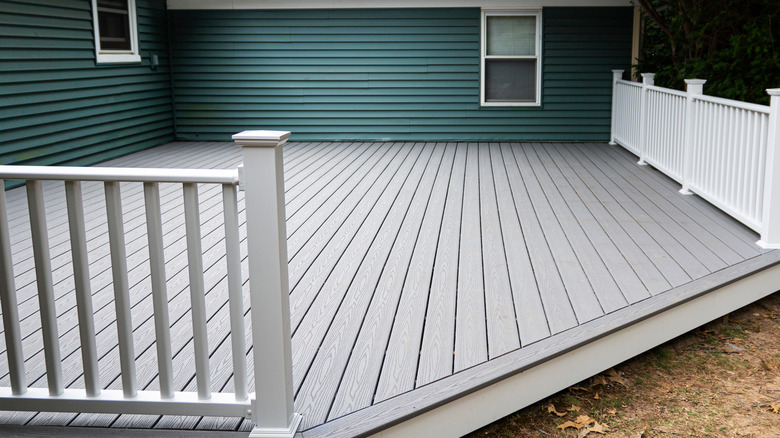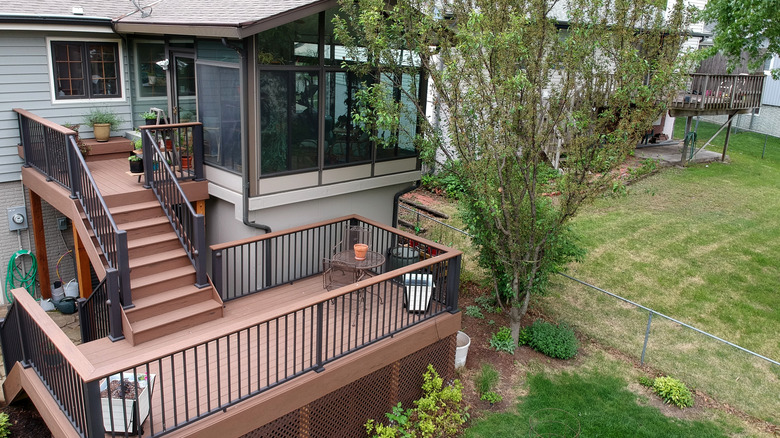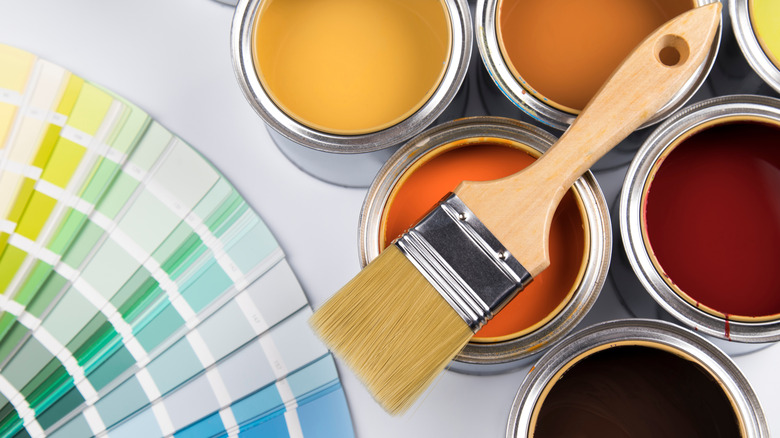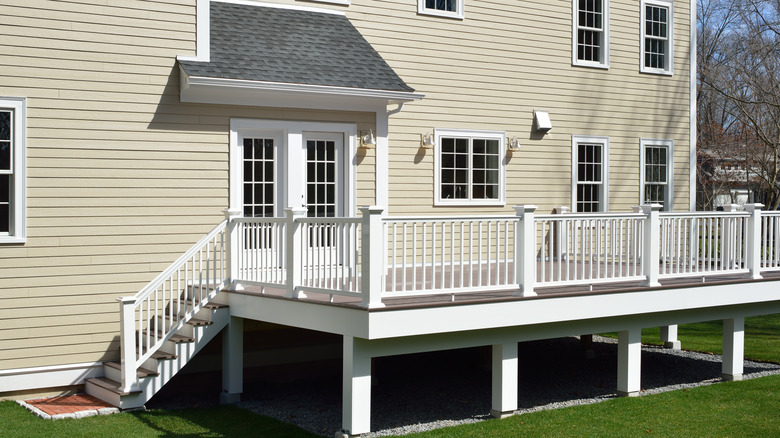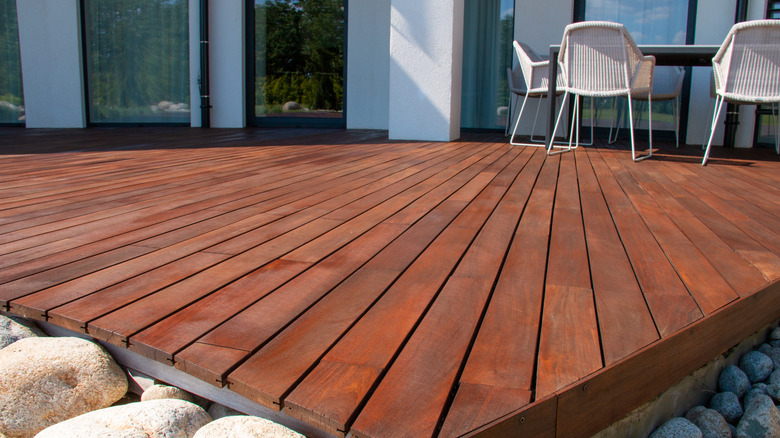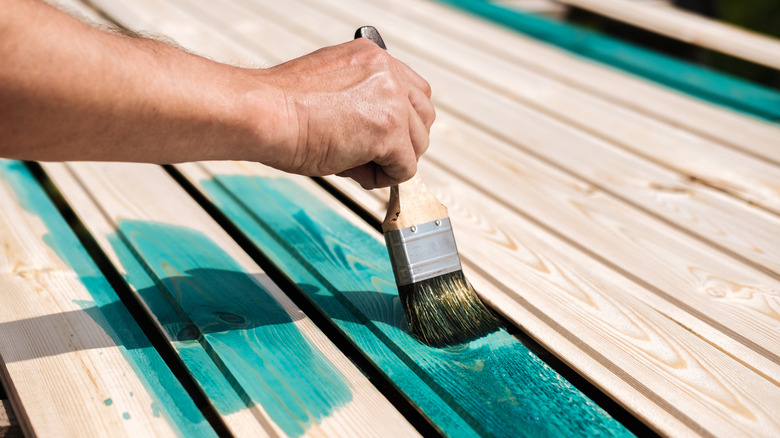5 Tips For Choosing A Deck Color That Complements Your Home's Exterior
Think of your deck as a visual extension of your home. As such, it plays a significant role in how neighbors and passersby perceive you. Choosing a color for your deck revolves around a very few simple principles. First and foremost, you're looking to complement the style and color of your house. But you should also consider any landscaping surrounding your deck because you don't want your deck to compete for focus with something like a prized garden.
In addition, consider the material of your deck before choosing a paint color. Materials like brick, stone, and cement are sometimes used in deck construction, and homeowners often prefer to seal them against the weather and enjoy them as they are. There are metal and vinyl decks, too, and as Miami Metal Decks explains, metal decks can be painted just like any other surface. Citywide Sundecks warns, however, that vinyl is a nightmare to paint, and your deck will soon lose its color in high-traffic areas because there's nothing in vinyl for the paint to adhere to — even if you use a primer.
Once you know what material you're working with, choosing the right color is a relatively straightforward process because there are not many ways to go wrong. You'll either choose to paint or decide to stain if you're looking to preserve the natural color of a wood surface.
1. Choose congruent colors
You should always pick a color palette for your deck that complements not only the color of the house but the style as well. Many modern homeowners gravitate toward more neutral colors because they're contemporary and easy to keep clean.
But what you're really looking for is congruence. You want a deck that looks like it belongs to the house and is an organic extension of the inside of your home. To tie everything together that way, many professionals suggest that you pick from the palette of colors most readily available: they're the colors your house is already painted in.
However, if you simply use the dominant color of your home for the deck, you'll wind up with something that looks like a big bland blob. Instead, according to the folks at Keystone Custom Decks, you should consider painting your deck in a contrasting color, possibly from the colors used as accents on the house, including borders or siding. Remember that if you're going with white, you will be spending extra time making sure it looks clean. Darker colors will be more forgiving.
Keep your house in mind and consider whether people can see your deck from the street because if you're going to the expense of painting and using time you could be spending elsewhere, you want to keep your curb appeal high. Picking the right color combination certainly won't hurt your home's value, either.
2. Use a color wheel and test samples
The folks at Paintzen say that you should also consider the environment when evaluating what color to choose. For example, a color like red will contrast beautifully with a mostly green landscape. If you have a colorful assortment of plants, going neutral will help keep them at center stage. Another option, if the deck is attached to the house, is to bring the color of the indoor floor outside.
Professionals recommend that you use the color wheel because it's easier to see how the colors work together. Typically, you'll pick three colors: one to dominate, another to complement, and a third as an accent.
Once you choose some color options, paint an inconspicuous place with a sample. Try wilder and more subdued colors, different brands, and types of paint. Since stains also carry color, try sanding a spot and testing different stains. Then check your work at different times of the day as the sun makes its way overhead.
One advantage to spending so much time in deliberation is that you'll likely get a result you like and can live with for years at a time. And that's why you'd want to take any of these suggestions and test them before you commit.
3. Consider different types of paint
Some homeowners pick their colors based on what will provide the best result. While the colors themselves may be as widely available in any type of paint, not all paint adheres, dries, or lasts the same. These factors affect how well your colors are absorbed into the materials you're painting and might saddle you with constant touch-ups or a complete redo before you're ready.
That's why it's important to know the differences between the three basic types of deck paint: water-based, oil-based, and polyurethane-based. Each has its pros and cons.
Liquid Rubber explains that oil-based paints were once the industry standard. They're durable and offer great moisture protection, and because they're easy to work with, you can get results nearly indistinguishable from professional work. But these paints are anything but eco-friendly and contain chemicals that can irritate your eyes and throat. Cleanup requires turpentine or thinner, and the paints are very slow to dry.
Water-based paints are more eco-friendly and resistant to fading easier, but they don't last as long. The life expectancy of a water-based paint job is between four and eight years.
Polyurethane may be the best option, but there are so many compounds on the market that it can be tough to determine which ones are best. Conversely, these paints are also environmentally friendly, and the sealants appear in clear colors across the spectrum. Moreover, its plastic coating is virtually impenetrable and will far outlast water- or oil-based paints.
4. Try using stain instead
With paint having more color choices, why would anyone choose to stain instead? The answer is simple. You're a fan of natural wood, and you want the texture or color to shine through.
As the writers at Forbes will tell you, homeowners gravitate toward either paint or stain based as often on performance as color. You'll certainly have access to more hues of the rainbow with paint, which also contains UV blockers and anti-slip components. But there's nothing like the luster of natural wood grain. It adds a certain gravitas to the entire home, and since it's the bridge between your house and nature, it makes for a more organic transition.
There aren't many different options with stains. Stains fit into one of three categories: solid, semi-transparent, and clear. The less translucent, the more protection your stain will offer you against the elements. Polyurethane sealants are often used in combination with these to add extra durability.
Remember that your deck will likely get more abuse and traffic than almost any other area of your home. The sun will bake it in the summer, you'll see snow piled up on it in wintertime, and it'll get soaked from rainfall. Add to that the daily influx of kids and pets, spills of wine, and barbecue sauce, and you can determine if paint or stain is the best option for your family.
5. Consider popular colors
Once you understand the particulars, picking colors is perhaps the most fun part of the project. With all that said, what are the color choices considered most on-trend today?
The most popular deck color is gray, but there are multiple choices within that range. From lighter slate to darker tones, gray goes with almost anything, looks lived-in clean even when it could use a sweep, and can be paired with undertones that pick up the colors of your house. It doesn't glare and won't absorb heat from the sun the way darker colors will. Deck Bros also recommends a new favorite among designers: greige, which combines gray and beige elements for a subtle earthy look.
If you're near water (or wish you were), the more nautical choice is a dark blue, say the experts at SurePro Painting. It's a bit of a novelty color out in middle America, but for anyone up and down the coasts, a rich blue will conjure images of seagulls circling overhead on sunny days. It's a good deal more cheery than gray but also less versatile.
Green or turquoise might suit you if you're looking to evoke the surrounding environment. And if you're looking to paint rather than stain your wooden deck, many homeowners find that chocolate brown or even black work well. On the downside, these do not hide footprints or dirt any better than white, and they will heat up in the summer sunshine.
